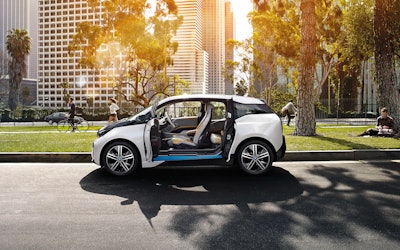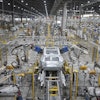
At the New York International Auto Show in February, PD&D editors had the chance to look up close at the electric cars and chargers on display. While electric tech is trendy and record-setting news — Tesla has set a record for any single product release with its Model 3 — the all-electric vehicles were still niche, made in one or two varieties by each brand.
Customer demand and brand awareness are locked in a chicken-or-the-egg situation at the moment when it comes to electric cars. More people need to be aware of them in order for companies and dealerships to sell more of them, and there need to be more electric cars on the road in order for consumers to be aware. One of the things that may be preventing the proliferation of EVs is a lack of a reliable charging network. Stricken with “range anxiety,” customers worry about running out of charge and not being able to find anywhere to refill.
We spoke to several companies about the proliferation of electric vehicle charging stations and how providers are working together to make a network as convenient — but better for the environment — than gas stations. BMW is working on proliferating its charging points and eliminating range anxiety — making sure people will get to “Grandma’s over Thanksgiving,” as testing and validation department head Heathcliff Fietzek said.
Likewise, companies like Delta Products Corporation, a subsidiary of Delta Electronics, have their fingers on the pulse of EV infrastructure.
As of February 2016, there were 12,271 public electric vehicle charging stations and 30,847 public charging outlets in the United States. By far, California was the front-runner in terms of providing them: as of March 2015, there were 2,441 stations in California, followed by 716 in Texas. There were 740,000 electric vehicles in use worldwide in 2015, up from 405,000 in 2014.
 (AP Photo)
(AP Photo)In BMW’s case, they wanted to partner with charging network providers. “When we rolled out the cars in the US we started to install at all our BMW 1 dealers Level 2 charging stations, which can be used by every electric car out there now,” said Fietzek. All electric BMWs made in 2015 or later have fast charging capability built in, and can work with all available charging network providers.
At first, some cars like the Mini-e had proprietary connectors because the standards had not yet been developed. As standards for both AC and DC charging were developed, there were some roadblocks as different standardizing bodies wanted to establish their own regulations. China in particular wanted to set its own AC standard independent of international standards, Fietzek said.
Stan Chao, program manager for EVSE at Delta Products Corporation, is also deeply involved with the proliferation of electric chargers. He said that some standards have emerged as definitive, while others coexist.
For Level 2 charging, most people follow the J1772 standard from the Society of Automotive Engineers. For DC charging there are three main standards that require three different connectors: SAE Combo for European and American EVs, CHAdeMO for Asian EVs and Tesla’s proprietary version. Delta knew that it needed to adapt to this, so their DC fast charging stations have dual charging ports that can connect to either SAE Combo or CHAdeMO vehicles. Since Tesla owners are provided with an optional adaptor that make the vehicle compliant with CHAdeMO charging stations, Delta’s DC fast charging stations can accommodate all three standards.
Chao said that he thinks these standards will coexist for at least the next three to four years.
Location is consideration when it comes to how quickly charging networks will proliferate and where companies should target when they’re in the charging market. Most people charge at home or at work, Chao said. Workplaces are one of the fastest growing markets. Home installation is still more common, but, Chao said, workplaces are going to need to figure out the best way to bill their employees for the electricity they use, or whether they’re going to do that at all. Public charging stations now either accept cards or use a membership-based billing system.
 The BMW i3. (Image credit: BMW)
The BMW i3. (Image credit: BMW)Public places like rest stops and hotels can allow for DC fast chargers, but not all locations have the right setup for 480-volt charging.
“As more and more vehicles come out with bigger batteries and long ranges, like the Chevy Bolt and the Tesla Model 3 with more than 200 miles of range, there will probably be more a demand for these chargers.”
In total, Chao said, he thinks that a 4:1 ratio of cars to charging stations need to be in place in order to make EVs mainstream.
To the question of how well companies are doing in making consumers aware that resources for electric cars are available, Chao gave a skeptical “Okay.”
“It is sufficient on the West Coast. It needs some work, but it’s more the signing and advertising. It’s not that there aren’t chargers there, but that people don’t know about it. It’s more the information about it.”
As for BMW, Fietzek said that dealers and consumers do know how to handle buying and selling electric cars. “It’s not a new electrical toy any more, it’s a serious car which you can use every day.”
He has a plug-in electric vehicle, himself, and says that his three-year-old has taken to reminding him to plug the car in.
Fietzek said that “future-proofing” includes both encouraging standards for chargers and producing long-range EVs, creating a system that encourages comfortable long-range travel. For now, there are other ways to mitigate range anxiety: the BMW i3 comes with an optional “range extender,” a gasoline engine that can be used in emergencies. Plug-in hybrids are also a good step to transition from gasoline to electric.
Countries like Norway, which have the highest EV ownership per capita and already selling EVs as 10 percent of their total vehicles, Chao said. In the United States, it’s less than 1 percent. “I think it will take a long time to achieve that 4:1 ratio. In my option it would probably take maybe another 20 or more years,” said Chao.
Until then, providers and auto manufacturers are doing the work of making chargers and cars compatible, and thinking about big questions. Outside the realm of the chargers themselves, how would an increased draw on electricity affect the grid? Companies like BMW and Delta are working on exploring those problems, dealing with the “chicken or the egg” problem one charger at a time.






















